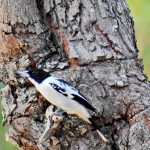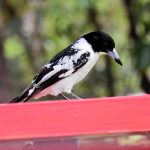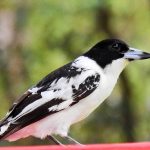BLACK-BACKED BUTCHERBIRD
The Black-backed Butcherbird: A Story of Song and Survival
The Black-backed Butcherbird (Cracticus mentalis) is a captivating songbird native to northern Australia and southern New Guinea. With its striking appearance and melodious call, this bird is a fascinating figure in the Australian landscape.
Physical Description
Imagine a bird about the size of a thrush, with a sleek body and sharp, intelligent eyes. Its plumage is a bold contrast:
- Back and wings: Glossy black, absorbing the sunlight like a velvet cloak.
- Belly and underparts: Crisp, clean white.
- Head: Mainly white, with a distinctive black crown and nape.
- Bill: Sturdy and slightly hooked—perfect for its predatory lifestyle.
When the sun rises over the eucalyptus woodlands, the Black-backed Butcherbird glimmers among the branches, the black and white feathers creating a living monochrome painting.
Habitat and Range
The Black-backed Butcherbird prefers:
- Open woodlands
- Forest edges
- Mangroves
- Urban gardens in parts of northern Queensland and the Northern Territory
You’ll often hear their calls before you see them, echoing through the humid morning air, blending with the scent of damp earth and the rustle of leaves.
Behaviour and Diet
The Hunter’s Song
This bird is renowned for its rich, flute-like song—a clear, ringing melody that adds music to the dawn. But beneath its musical exterior lies a skilled hunter.
- Diet: Small reptiles, insects, and occasionally, other birds and mammals.
- Hunting style: It perches silently, watching for movement. With a sudden swoop, it seizes its prey, often impaling it on a sharp twig or in the fork of a branch—a behaviour that gives the butcherbird its name.
Family Life
Black-backed Butcherbirds are usually seen alone or in pairs. They are attentive parents, building sturdy nests high in the trees, woven from twigs and lined with softer materials. The air is filled with the gentle calls of fledglings, their feathers still soft, as both parents tirelessly feed and protect their young.
Sensory Experience
- Sight: Glimpse their black-and-white form darting among sun-dappled branches.
- Sound: Hear their haunting, melodious calls rising above the morning chorus.
- Touch: Imagine the rough bark beneath their feet as they perch, ever-watchful.
- Smell: Sense the fresh, earthy aroma of the woodland after rain.
Conservation and Connection
While the Black-backed Butcherbird is not considered threatened, the health of its habitat is vital. The bird is a reminder of the delicate balance within Australia’s ecosystems. Preserving wooded areas and encouraging native gardens can help ensure future generations will continue to hear its beautiful song.
Quick Facts Table
| Feature | Description |
|---|---|
| Scientific Name | Cracticus mentalis |
| Size | About 28–32 cm (11–12.5 in) |
| Diet | Insects, small reptiles, small birds/mammals |
| Habitat | Northern Australia, southern New Guinea |
| Conservation Status | Least Concern |
Final Thoughts
The Black-backed Butcherbird is more than just a striking bird—it’s a symbol of Australia’s vibrant, interconnected wild places. By learning about and appreciating such species, we take a step closer to preserving the wild music and diversity of our natural world.
If you ever hear its song drifting across the trees, take a moment to listen. You’re sharing a timeless connection with one of nature’s most remarkable musicians.



